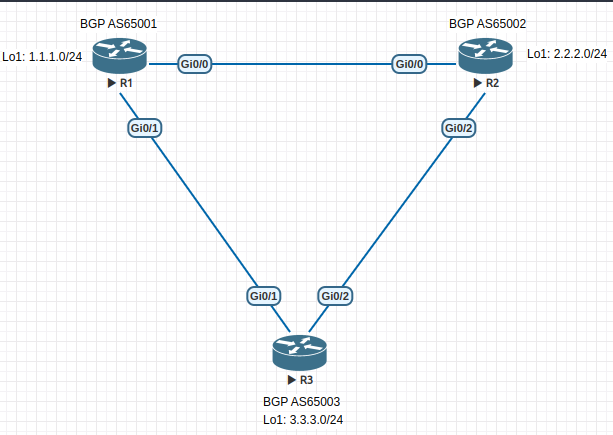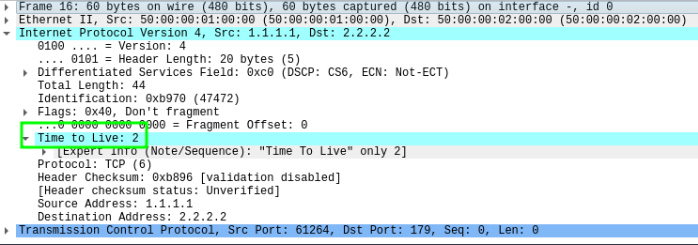–
Summary
- The
bgp neighbour X.X.X.X ebgp-multihop <value>command is used to set the multihop value - eBGP messages are sent with a TTL of 1 by default
- The
show ip bgp neighbors | i Externalcommand is used to check the ebgp-multihop configuration - The multihop requirement does not affect iBGP peerings
eBGP Multihop

By default when configuring an eBGP neighbour, BGP expects the neighbours IP address to be less than 1 network hop away, or in other words, have a TTL of 1. BGP Multihop is used when the configured BGP neighbour IP address is greater than one hop away.
In this example I have configured each BGP router with a Loopback 1 interface, the IP addresses configured on these interfaces will be used to form a BGP session between each neighbour. The Loopback interfaces are greater than 1 hop away because they are not directly connected, there is one hop to the neighbouring routers directly connected interface, and then another hop “inside” of the router to reach the Loopback.
Because the neighbours Loopback interface are not directly connected we need a way for the routers to learn how to get to them. I have achieved this by creating OSPF adjacencies between the three routers and advertising the Loopback interfaces into OSPF.
The BGP command neighbor X.X.X.X update-source Loopback1 sets the Loopback1 interface as the source interface for any BGP messages sent to this neighbour. Because we are using Loopback1 as our BGP source interface for our peering with R2, our BGP messages will traverse 2 hops as depicted in the diagram below.

The BGP command bgp neighbour X.X.X.X ebgp-multihop <value> is used to increase the TTL of BGP messages sent to this neighbour. Below is a packet capture of a BGP TCP SYN message displaying a TTL of 2, which is the minimum numbers of hops required to establish a BGP peering in our topology. To set this value I used the neighbour 2.2.2.2 ebgp-multihop 2 command on R1 and the neighbour 1.1.1.1 ebgp-multihop 2 on R2. If you were to look at a packet capture of a default BGP ebgp-multihop configuration the TTL value would show 1.

The hop value can be confirmed with the show ip bgp neighbors | i External command.
R1#show ip bgp neighbors | i External
External BGP neighbor may be up to 2 hops away.
Configurations
R1
!
hostname R1
!
interface Loopback1
ip address 1.1.1.1 255.255.255.0
ip ospf 1 area 0
!
interface GigabitEthernet0/0
ip address 10.0.12.1 255.255.255.0
ip ospf 1 area 0
!
interface GigabitEthernet0/1
ip address 10.0.13.1 255.255.255.0
ip ospf 1 area 0
!
router ospf 1
router-id 1.1.1.1
passive-interface default
no passive-interface GigabitEthernet0/0
no passive-interface GigabitEthernet0/1
!
router bgp 65001
bgp router-id 1.1.1.1
neighbor 2.2.2.2 remote-as 65002
neighbor 2.2.2.2 ebgp-multihop 2
neighbor 2.2.2.2 update-source Loopback1
neighbor 3.3.3.3 remote-as 65003
neighbor 3.3.3.3 ebgp-multihop 2
neighbor 3.3.3.3 update-source Loopback1
!
address-family ipv4
network 1.1.1.0 mask 255.255.255.0
neighbor 2.2.2.2 activate
neighbor 3.3.3.3 activate
exit-address-family
!
R2
!
hostname R2
!
interface Loopback1
no shutdown
ip address 2.2.2.2 255.255.255.0
ip ospf 1 area 0
!
interface GigabitEthernet0/0
ip address 10.0.12.2 255.255.255.0
ip ospf 1 area 0
media-type rj45
!
interface GigabitEthernet0/2
ip address 10.0.23.2 255.255.255.0
ip ospf 1 area 0
!
router ospf 1
router-id 2.2.2.2
passive-interface default
no passive-interface GigabitEthernet0/0
no passive-interface GigabitEthernet0/2
!
router bgp 65002
bgp router-id 2.2.2.2
neighbor 1.1.1.1 remote-as 65001
neighbor 1.1.1.1 ebgp-multihop 2
neighbor 1.1.1.1 update-source Loopback1
neighbor 3.3.3.3 remote-as 65003
neighbor 3.3.3.3 ebgp-multihop 2
neighbor 3.3.3.3 update-source Loopback1
!
address-family ipv4
network 2.2.2.0 mask 255.255.255.0
neighbor 1.1.1.1 activate
neighbor 3.3.3.3 activate
exit-address-family
!
R3
!
hostname R3
!
interface Loopback1
ip address 3.3.3.3 255.255.255.0
ip ospf 1 area 0
!
interface GigabitEthernet0/1
ip address 10.0.13.3 255.255.255.0
ip ospf 1 area 0
!
interface GigabitEthernet0/2
ip address 10.0.23.3 255.255.255.0
ip ospf 1 area 0
!
router ospf 1
router-id 3.3.3.3
passive-interface default
no passive-interface GigabitEthernet0/1
no passive-interface GigabitEthernet0/2
!
router bgp 65003
bgp router-id 3.3.3.3
neighbor 1.1.1.1 remote-as 65001
neighbor 1.1.1.1 ebgp-multihop 2
neighbor 1.1.1.1 update-source Loopback1
neighbor 2.2.2.2 remote-as 65002
neighbor 2.2.2.2 ebgp-multihop 2
neighbor 2.2.2.2 update-source Loopback1
!
address-family ipv4
network 3.3.3.0 mask 255.255.255.0
neighbor 1.1.1.1 activate
neighbor 2.2.2.2 activate
exit-address-family
!